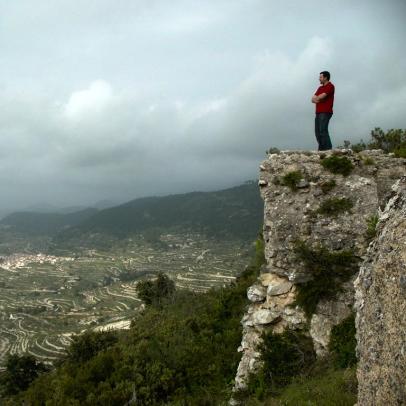Castle of Carbonera, situated between Otos and Beniatjar

Located about 4 kms from Otos and Beniatjar. Ride or walk along road CV 615 and then on a trail, which will take you up walking close to the hill Otos
In spite of the fact that the castle ruins may suggest the contrary, this is one of the most symbolic places on The Way of El Cid. An onsite visit can play a fundamental role in understanding this place’s strategic importance in the 11th century and the tireless efforts El Cid and his men went through.
Taking into account that the Mediterranean Sea covered in the 11th century a larger surface area, it is easy to see why the castle was situated in a strategic location in the taifas of Valencia and Denia.
In 1091 the real El Cid took control of this region and rebuilt the castle, which the Arabs had destroyed before taking leave. He had an impregnable wall built around the castle and established a garrison with weapons and supplies.
This fortress, from where it is possible to see stunning views, is located on a strategic spot called Carbonera, along the border between Otos and Beniatjar. Late in August 1093, El Cid launched an attack against the town of Alzira after which he stayed at Peña Cadiella, from where he attacked and raided Villena. In January 1097, El Cid begged Pedro I for help against an Almoravid invasion. Pedro I came to Valencia with his army. It is very likely that he arrived to the city in the company of his brother, who would become Alfonso the Battler. The three of them went to Peña Cadiella to help this strategically important plaza.
Following Rodrigo’s death, Jimena held Valencia for a time but would then abandon the city, after which the castle was taken by the Almoravids. In 1124, Alfonso I the Battler ordered a group of Aragoneses, Franks, Gascons and Templars to take control of the fortress. These knights remained at the fortress several weeks, withstanding attacks and plundering the region. They abandoned the fortress, leaving 60 men in charge of this plaza. Yet, they were unable to keep control of the fortress. One year later the fortress was occupied by Alfonso I the Battler, who most likely was familiar with the place. One century later James I the Conqueror would eventually take control of the fortress.
In El Cantar de Mío Cid there are also references to this fortress: after the battle of Sagunto, the literary El Cid plundered the region of the taifa of Valencia, launching quick attacks during the night, which caused great distress among the peoples of Cullera, Xàtiva and Denia. He then took the castle of Peña Cadiella, a military action which caused anxiety in the cities of Cullera, Xátiva and Valencia. It took El Cid three years to take control of the region.
The only remains still standing are the bases of the walls, which are 1.85 metres wide and are made of limestone, the buttresses of some towers and the main tank. The portions of the wall that are best preserved are situated in the northern side. The remains mix with the surface components of the hill on which the castle ruins stand; i.e. the crag of Castellet, which is situated in between the gulleys of Loma and Carbonera. The views are stunning.
Rev. PAB 27.12.18

